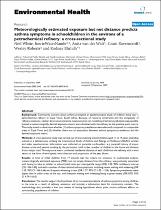 ResearchSpace
ResearchSpace
Meteorologically estimated exposure but not distance predicts asthma symptoms in schoolchildren in the environs of a petrochemical refinery: a cross-sectional study
JavaScript is disabled for your browser. Some features of this site may not work without it.
- ResearchSpace
- →
- Research Publications/Outputs
- →
- Journal Articles
- →
- View Item
| dc.contributor.author |
White, N

|
|
| dc.contributor.author |
teWaterNaude, J

|
|
| dc.contributor.author |
Van der Walt, A

|
|
| dc.contributor.author |
Ravenscroft, G

|
|
| dc.contributor.author |
Roberts, W

|
|
| dc.contributor.author |
Ehrlich, R

|
|
| dc.date.accessioned | 2012-04-17T09:29:26Z | |
| dc.date.available | 2012-04-17T09:29:26Z | |
| dc.date.issued | 2009-09 | |
| dc.identifier.citation | White, N, teWaterNaude, J, Van der Walt, A, Ravenscroft, G, Roberts, W and Ehrlich, R. 2009. Meteorologically estimated exposure but not distance predicts asthma symptoms in schoolchildren in the environs of a petrochemical refinery: a cross-sectional study. Environmental Health, 8:45 doi:10.1186/1476-069X-8-45 | en_US |
| dc.identifier.issn | 1476-069X | |
| dc.identifier.uri | http://www.ehjournal.net/content/pdf/1476-069X-8-45.pdf | |
| dc.identifier.uri | http://hdl.handle.net/10204/5773 | |
| dc.description | Copyright: 2009 White et al; licensee BioMed Central Ltd. This is an Open Access article distributed under the terms of the Creative Commons Attribution License (http://creativecommons.org/licenses/by/2.0), which permits unrestricted use, distribution, and reproduction in any medium, provided the original work is properly cited. | en_US |
| dc.description.abstract | Community concern about asthma prompted an epidemiological study of children living near a petrochemical refinery in Cape Town, South Africa. Because of resource constraints and the complexity of refinery emissions, neither direct environmental measurements nor modelling of airborne pollutants was possible. Instead a meteorologically derived exposure metric was calculated with the refinery as the putative point source. The study aimed to determine whether (1) asthma symptom prevalences were elevated compared to comparable areas in Cape Town and (2) whether there was an association between asthma symptom prevalences and the derived exposure metric. | en_US |
| dc.language.iso | en | en_US |
| dc.publisher | BioMed Central | en_US |
| dc.relation.ispartofseries | Workflow;8475 | |
| dc.subject | Asthma | en_US |
| dc.subject | Asthma symptoms | en_US |
| dc.subject | Refinery emissions | en_US |
| dc.subject | Environmental health | en_US |
| dc.subject | Air pollution | en_US |
| dc.subject | Cape Town petrochemical refinery | en_US |
| dc.subject | Petrochemical refinery | en_US |
| dc.subject | Children's health | en_US |
| dc.title | Meteorologically estimated exposure but not distance predicts asthma symptoms in schoolchildren in the environs of a petrochemical refinery: a cross-sectional study | en_US |
| dc.type | Article | en_US |
| dc.identifier.apacitation | White, N., teWaterNaude, J., Van der Walt, A., Ravenscroft, G., Roberts, W., & Ehrlich, R. (2009). Meteorologically estimated exposure but not distance predicts asthma symptoms in schoolchildren in the environs of a petrochemical refinery: a cross-sectional study. http://hdl.handle.net/10204/5773 | en_ZA |
| dc.identifier.chicagocitation | White, N, J teWaterNaude, A Van der Walt, G Ravenscroft, W Roberts, and R Ehrlich "Meteorologically estimated exposure but not distance predicts asthma symptoms in schoolchildren in the environs of a petrochemical refinery: a cross-sectional study." (2009) http://hdl.handle.net/10204/5773 | en_ZA |
| dc.identifier.vancouvercitation | White N, teWaterNaude J, Van der Walt A, Ravenscroft G, Roberts W, Ehrlich R. Meteorologically estimated exposure but not distance predicts asthma symptoms in schoolchildren in the environs of a petrochemical refinery: a cross-sectional study. 2009; http://hdl.handle.net/10204/5773. | en_ZA |
| dc.identifier.ris | TY - Article AU - White, N AU - teWaterNaude, J AU - Van der Walt, A AU - Ravenscroft, G AU - Roberts, W AU - Ehrlich, R AB - Community concern about asthma prompted an epidemiological study of children living near a petrochemical refinery in Cape Town, South Africa. Because of resource constraints and the complexity of refinery emissions, neither direct environmental measurements nor modelling of airborne pollutants was possible. Instead a meteorologically derived exposure metric was calculated with the refinery as the putative point source. The study aimed to determine whether (1) asthma symptom prevalences were elevated compared to comparable areas in Cape Town and (2) whether there was an association between asthma symptom prevalences and the derived exposure metric. DA - 2009-09 DB - ResearchSpace DP - CSIR KW - Asthma KW - Asthma symptoms KW - Refinery emissions KW - Environmental health KW - Air pollution KW - Cape Town petrochemical refinery KW - Petrochemical refinery KW - Children's health LK - https://researchspace.csir.co.za PY - 2009 SM - 1476-069X T1 - Meteorologically estimated exposure but not distance predicts asthma symptoms in schoolchildren in the environs of a petrochemical refinery: a cross-sectional study TI - Meteorologically estimated exposure but not distance predicts asthma symptoms in schoolchildren in the environs of a petrochemical refinery: a cross-sectional study UR - http://hdl.handle.net/10204/5773 ER - | en_ZA |





